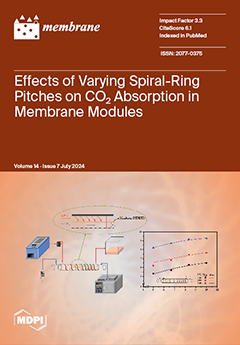The escalating emissions of CO
2 into the atmosphere require the urgent development of technologies aimed at mitigating environmental impacts. Among these, aqueous amine solutions and polymeric membranes, such as cellulose acetate and polyimide are commercial technologies requiring improvement or substitution to enhance
[...] Read more.
The escalating emissions of CO
2 into the atmosphere require the urgent development of technologies aimed at mitigating environmental impacts. Among these, aqueous amine solutions and polymeric membranes, such as cellulose acetate and polyimide are commercial technologies requiring improvement or substitution to enhance the economic and energetic efficiency of CO
2 separation processes. Ionic liquids and poly(ionic liquids) (PILs) are candidates to replace conventional CO
2 separation technologies. PILs are a class of materials capable of combining the favorable gas affinity exhibited by ionic liquids (ILs) with the processability inherent in polymeric materials. In this context, the synthesis of the IL GLYMIM[Cl] was performed, followed by ion exchange processes to achieve GLYMIM variants with diverse counter anions (NTf
2−, PF
6−, and BF
4). Subsequently, PIL membranes were fabricated from these tailored ILs and subjected to characterization, employing techniques such as SEC, FTIR, DSC, TGA, DMA, FEG-SEM, and CO
2 sorption analysis using the pressure decay method. Furthermore, permeability and ideal selectivity assessments of CO
2/CH
4 mixture were performed to derive the diffusion and solubility coefficients for both CO
2 and CH
4. PIL membranes exhibited adequate thermal and mechanical properties. The PIL-BF
4 demonstrated CO
2 sorption capacities of 33.5 mg CO
2/g at 1 bar and 104.8 mg CO
2/g at 10 bar. Furthermore, the PIL-BF
4 membrane exhibited permeability and ideal (CO
2/CH
4) selectivity values of 41 barrer and 44, respectively, surpassing those of a commercial cellulose acetate membrane as reported in the existing literature. This study underscores the potential of PIL-based membranes as promising candidates for enhanced CO
2 capture technologies.
Full article






